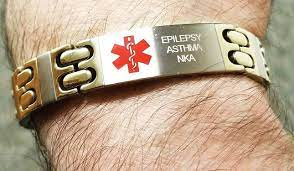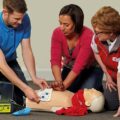Q. A Medic Alert Bracelet Might Indicate That A Customer:
- Has a medical condition that might mimic intoxication.
- Should not drink because of a medical condition.
- Is not allowed to drink alcohol.
- May become intoxicated quickly.
ANSWER: 1. Has a medical condition that might mimic intoxication.
What is Medic Alert Bracelet?
A medical alert bracelet is a jewelry that contains your personal medical information which enables first responders to assist in cases of emergency. Wearing your medical information is a great way to alert others with your details which can help prevent an event from turning into a life-threatening emergency.
Medical identification tags are stamped with specific symbols that alert emergency responders that you have a condition (like diabetes, a heart condition, an allergy, etc.) that requires attention, in case you’re unable to speak for yourself. Paramedics know to look out for these IDs, usually worn on your body, and the tags can contain as little or as much info as you need (i.e., diagnosis, emergency contacts, directions).
Much like a wedding ring, you should theoretically wear a piece of medical jewelry every day, as you never know when a situation like a seizure will arise.
You need medical alert jewelry if:
- You have a condition that might cause a medical emergency, and/or
- You have a condition medical professionals need to know about in an emergency, and/or
- You are a caregiver for someone with one or both of the above.
Medical identification jewelry is designed to speak for you when you cannot. If you’ve been diagnosed with a chronic condition, have food or drug allergies, or take medications, then you should wear a medical ID. Any of the following conditions may alter the treatment you might normally receive.
Among important information to consider listing on medical ID jewelry:
- Medical conditions: Include any chronic medical conditions such as asthma, cardiovascular concerns, diabetes, epilepsy, and so on. In particular, be sure to list any conditions that may render you or your loved one unable to communicate with emergency staff (e.g., seizure disorder) and/or could be fatal.
- Medications: If you are taking a blood-thinning medication, list it at the top of your medical alert jewelry. This alerts emergency personnel that you could be bleeding internally if you’ve been injured. Similarly, if you have a severe allergy to a medication, list it so that it is not administered in an emergency situation.
- Medical devices: For example, if you have a pacemaker.
- Blood type: In some circumstances (i.e., you have a blood disorder), listing your blood type may also be advisable.
- If you have transplanted or missing organs: You may be taking immunosuppressant medications, which can make you especially susceptible to infection.
- Communication/cooperation challenges: Having schizophrenia or autism, or limitations such as being non-verbal or deaf, are a few examples of things you may want to list so that a care team is aware of why you or your loved one may not respond as expected.
- Do not resuscitate (DNR) orders: There’s only one medical intervention so important that it takes a healthcare provider’s order not to perform it: CPR. If you have a do not resuscitate order—an order not to perform CPR if doing so would be necessary to save your life—you should wear something that says just that.
- Instructions: Such as “call 911” or the phone number of your emergency contact. This may be useful for bystanders as well.
Replace medical alert jewelry over time if there is a significant change in your medical needs that should be reflected.






